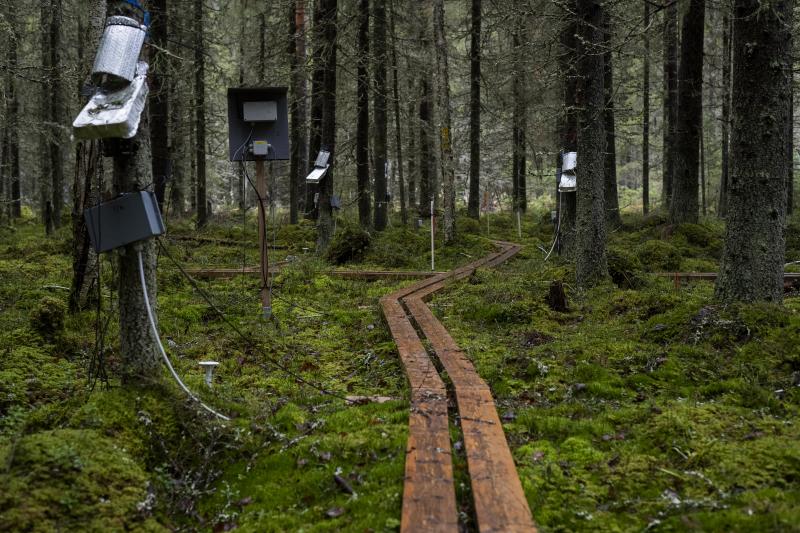Forest soil can mitigate or accelerate climate change - Luke-led research project examines soil properties and processes in detail
Trees absorb carbon as they grow, but forest soil also contributes to climate change. However, assessments of soil impacts on climate change are very uncertain and often overlooked in national or EU-level decisions. Now common tools for measuring and predicting impacts are being developed in the HoliSoils project, which is led by Natural Resources Institute Finland (Luke).
How big an emission source or a carbon sink is the forest soil? How can we influence this with forest management? These are core questions when EU countries strive to strengthen carbon sinks in the land use sector and mitigate climate change. However, reliable answers are scarce.
"In Europe, decision-making regarding forests is supported by scenario tools, which often lack soil completely. This is a serious shortcoming, because forest management methods affect soil as well as trees, and sometimes even in opposite ways," says Luke's research professor Raisa Mäkipää.
Mäkipää leads the EU-funded HoliSoils project together with Luke's research professor Aleksi Lehtonen. The project examines how different forest management practices affect the carbon stock, greenhouse gas balances and microbial biodiversity in forest soil. The project creates common methods for measuring change and models for predicting it.
"At Luke, we have been conducting national greenhouse gas inventories for a long time and we have also developed models that take forest soil into account. Now we can use this experience in the HoliSoils project," Lehtonen says.
Taking advantage of Finnish experimental forests with research equipment
Luke provided the HoliSoils project with two Finnish experimental forests, where climate-smart forest management methods are studied. In one of them, Luke's researchers have investigated the effects of nitrogen fertilization since 1959, and soil measurement data are available since the 1980s. New biodiversity and gas flux measurements are now being made in the HoliSoils project.
The second experimental forest is a nutrient-rich drained peatland, where an exceptionally wide range of measuring devices is permanently located both on the surface of the ground and underground and above the treetops, as well. The devices are used to measure, for example, the level of groundwater, the exchange of greenhouse gases and the growth of trees.
"In the project, we have been able to share our experience with different measurement methods, some of which have been used by just a few of our partners. For example, we can distinguish between soil respiration and plant root respiration. This helps when studying the factors affecting the decomposition of organic material in the soil," Mäkipää says.
Luke's researchers compare the effects of traditional forestry and continuous cover forestry on the soil in the peatland forest. In some parts of the forest, clear cutting and drainage are carried out, while in others the trees are felled by gradually picking so that there will be no large clearings and no need to renew the drainage.
"The results are interesting and show that continuous cover forestry can reduce emissions and even turn a nutrient-rich peatland forest from an emission source into a carbon sink," Mäkipää says.
Uniform measurement approaches and support for data management
In addition to Finland, climate-smart forest management experiments are being carried out in six other European countries and in Uruguay. Lehtonen leads the experiments and provides participants with tools for harmonizing measurement methods and managing data. Research objects were selected according to specific characteristics of each country.
"For example, in Spain, we compare traditional forest management with one that aims in particular to reduce the risk of forest fires. In Germany, on the other hand, we compare carbon sequestration in single-species forests of spruce to that of mixed forests," Lehtonen says.
Besides measuring greenhouse gas emissions, soil samples are also taken to assess the stability of soil carbon. Luke analyses the composition and quality of organic matter in each sample on behalf of all the participants.
Top researchers gather to share know-how
In addition to the composition, the soil's inhabitants, the microbes and on some sites also soil fauna, are studied. The goal is to find out how each microbial species or group is related to the production and consumption of greenhouse gases under study, i.e. carbon dioxide, methane and nitrous oxide. According to Mäkipää, Luke is highly skilled in microbial research, but in the HoliSoils project, samples are sent from all experimental forests to the Czech Republic.
"In the Czech Republic, there is a top researcher in the field, with whom we wanted to cooperate. One of the advantages of a large international research project is that we can gather top scientists together and benefit from each other's expertise," Mäkipää says.
Mäkipää and Lehtonen expect that the project will produce tools for all EU countries to use and thereby promote uniform monitoring and forecasting of greenhouse gas balances in forest soils - and thus mitigate climate change.
Who's leading the project?
Who's leading the project?
Text: Marianna Salin




